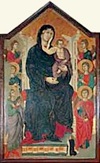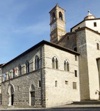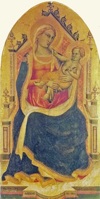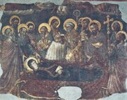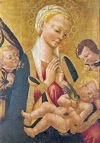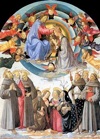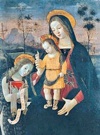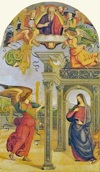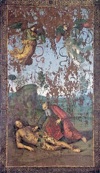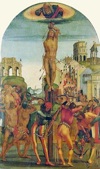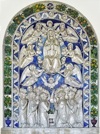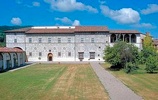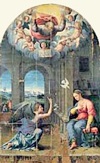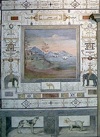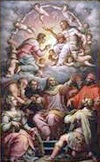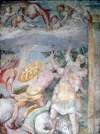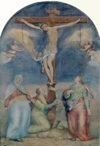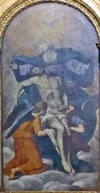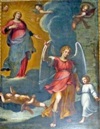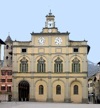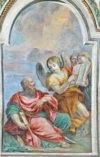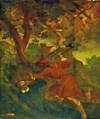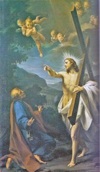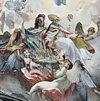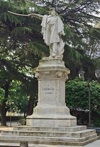

Maestro di Città di Castello (early 14th century)
Possibly from Siena
Angelo da Orvieto (died after 1337)
From Orvieto
Spinello Aretino (died 1410)
Spinello Aretino was an important artist who worked mostly in Tuscany. This panel (ca. 1400) of the Madonna and Child in the Pinacoteca Comunale, which is of uncertain provenance, is attributed to him.
Ottaviano Nelli (1375 - ca. 1450)
From Gubbio
Ottaviano was an important and prolific artist in his native city and the surrounding area. A fresco (15th century) of the Assumption of the Virgin in Santa Maria delle Grazie is attributed to him.
Neri di Bicci (1418-91)
Neri di Bicci trained in the Flroentine workshop of his father, Bicci di Lorenzo, and took it over when his father died. This altarpiece (15th century) of the Madonna and Child with angels , which came from Santa Cecilia and which is now in the Pinacoteca Comunale, is attributed to him.
Domenico Ghirlandaio (1449-94)
This altarpiece (15th century) of the Coronation of the Virgin, which is attributed to the workshop of Domenico Ghirlandaio, was documented in 1872 in Santa Cecilia, although it is not clear that this was its original location. It is now in the Pinacoteca Comunale. It is based on the altarpiece (1486) of the Coronation of the Virgin that Ghirlandaio painted for the Observant Franciscans of the Convento di San Girolamo, Narni, but is not of comparable quality.
Bernardino di Betto, Pintoricchio (ca. 1454–1513)
The panel (ca. 1485) of the Madonna and Child with the young St John the Baptist illustrated here was formerly in the Bufalini collection. This implies that Nicolò di Riccomanno, called Manno Bufalini di Città di Castello commissioned it, probably in Rome. (He also commissioned Pintoricchio to fresco the Cappella di San Bernardino in Santa Maria d' Aracoeli, Rome in 1484-6).
Pintoricchio also painted an important altarpiece (1502-5) of the Coronation of the Virgin for the church of Santa Maria della Pietà, la Fratta (now Umbertide), outside Città di Castello. It is now in the Pinacoteca Vaticana, Rome.
Francesco, il Tifernate (ca. 1505)
The signed and documented altarpiece (ca. 1505) of the Annunciation illustrated here is the only securely attributed work by this artist. He was a few years younger than Raphael, and was enormously influenced by Raphael’s work in Città di Castello (see below). A number of other works in and around the city are attributed to him.
Raphael (1483-1520)
Raphael’s earliest documented commission was for an altarpiece ca. 1500 for Sant’ Agostino, Città di Castello. He went on to paint another two altarpieces and a double-sided processional banner for churches in the city before ca. 1504. None of the altarpieces remains here, but two damaged panels that were formed when the banner was split are now in the Pinacoteca Comunale. One of them, which depicts the Holy Trinity with saints, is illustrated here.
Luca Signorelli (died 1523)
The following are in the Pinacoteca Comunale:
-
✴damaged fresco fragments (1494) of a Maestà with SS Paul and Jerome came from the Torre Civica;
-
✴an altarpiece (1498) of the martyrdom of St Sebastian from San Domenico (illustrated here), which was probably Signorelli’s last work in Città di Castello before he left for Orvieto, although his workshop continued;
-
✴a double-sided processional banner (ca. 1500) from San Giovanni Decollato; and
-
✴the huge Santa Cecilia Altarpiece (1516-7).
Frescoes (1507-10) in San Crescentino, Morra are also attributed to Luca Signorelli and his workshop.
Andrea della Robbia (1435-1525)
Andrea della Robbia inherited the workshop of his uncle, Luca della Robbia (died 1482), which was famous for its glazed ceramic reliefs in blue and white. Andrea extended the range by perfecting the use of other colours. A number of glazed terracotta reliefs (early 16th century) in the Pinacoteca Comunale are attributed to Andrea della Robbia or his workshop:
-
✴three from San Giovanni Battista, including this altarpiece of the Assumption of the Virgin, from the high altar; and
-
✴a small relief of the Annunciation from the nunnery of Santa Chiara della Cappuccine (later Santa Veronica).
Antonio Bencivenni (died 1528)
Antonio Bencivenni was a woodcarver who was based in Perugia in ca. 1498-1518 and subsequently in Todi. He signed this cabinet and a set of choir stalls from the sacristy of Santa Maria delle Grazie, which are now in the Pinacoteca.
Rosso Fiorentino (1494-1540)
Rosso worked in Rome in 1523-7 and then took refuge with Domenico Alfani in Perugia, after having been caught up in the horror of the sack of Rome. He moved to Sansepolcro and Città di Castello, where he painted this important panel (1528-30) of the Transfiguration for the Duomo. He left Italy for France in 1530.
Antonio da Sangallo il Giovane (1484-1546)
From Florence, based in Rome
Antonio da Sangallo il Giovane was one of the leading architects in Rome, particularly after the election of Pope Paul III in 1534. According to Giorgio Vasari, he worked for Alessandro Vitelli on Palazzo Vitelli alla Cannoniera in ca. 1534.
Raffaellino del Colle (1490–1556)
Raffaellino del Colle probably trained under Giovanni di Pietro, lo Spagna. He was working in the Vatican in 1520, immediately after the death of Raphael, and might have worked their earlier with Raphael himself. His stay in Rome lasted until 1524, after which he worked in Umbria, Tuscany and the Marches. The following panels (16th century) by or attributed to Raffaellino del Colle are in the Pinacoteca Comunale:
-
✴three panels Santa Maria delle Grazie:
-
•the Annunciation (illustrated here);
-
•the Deposition, from Santa Maria delle Grazie [Figure 79, Il Tesoro Perduto]; and
-
•the Presentation of the Virgin;
-
✴Assumption of the Virgin, from San Francesco; and
-
✴Annunciation, from San Domenico.
Cristofano Gherardi, il Doceno (1508-56)
Cristofano Gherardi worked under Giorgio Vasari (below) for Alessandro Vitelli on the external and internal frescoes (1534-7) of Palazzo Vitelli alla Cannoniera. He is also credited (like Vasari) with some of the frescoes (1572-4) in Palazzo Vitelli a Porta Sant' Egido, which were executed by a team under Prospero Fontana for Paolo Vitelli.
Tommaso Bernabei, il Papacello (died 1559)
From Cortona
An altarpiece (16th century) of the Adoration of the Shepherds in the Pinacoteca, which came from an altar in San Domenico that belonged to the Marchesani family, is stylistically close to an altarpiece in Montone that is signed by Vittore Cirelli and il Papacello. Some scholars attribute the altarpiece in Città di Castello to Vittore Cirelli but it has also been attributed to il Papacello.
[Temporary link to Tommaso Bernabei, il Papacello]
Giorgio Vasari (1511-74)
Although he is mainly remembered as an art historian, Giorgio Vasari was also a prolific painter and architect who enjoyed the patronage of the Medici of Florence throughout his career. His work in Città di Castello was mostly carried out for the Vitelli family:
-
✴work at Palazzo Vitelli alla Cannoniera (1534);
-
✴the design of Palazzo Vitelli a Porta Sant' Egido (ca.1540); and
-
✴the design of Cappella Vitelli (ca. 1564) in San Francesco, including the execution of its altarpiece of the Coronation of the Virgin, illustrated here.
He is also credited with some of the frescoes (1572-4) in Palazzo Vitelli a Porta Sant' Egido, which were executed by a team under Prospero Fontana for Paolo Vitelli.
Nicolò Circignani, il Pomarancio (died 1596)
From Pomarance, near Volterra, based in Rome
-
✴the Martyrdom of St Stephen (1570);
-
✴the Immaculate Virgin (1573); and
-
✴the Annunciation (1577).
He is also credited with some of the frescoes (1572-4) in Palazzo Vitelli a Porta Sant' Egido, which were executed by a team under Prospero Fontana for Paolo Vitelli. An altarpiece (ca. 1595) of the Annunciation in the Duomo was stolem
n. A fresco (16th century) of the Conversion of St Paul in the Cappella di San Paolo in the Duomo (illustrated here) is attributed to him. Three works in nearby Umbertide are by or attributed to Nicolò Circignani:
-
✴a signed altarpiece (1577) of the Madonna and saints from San Francesco, which is now in the Museo di Santa Croce;
-
✴an altarpiece (1577) of the Madonna and saints from the parish church of Romeggio, which is now in the church of the Abbazia di San Salvatore di Monte Corona; and
-
✴a signed altarpiece (1578) of the Transfiguration from San Salvatore di Monte Corona, which is now in in Santa Maria della Reggia.
Durante Alberti (1556–1623)
From Borgo Sansepolcro, based in Rome
-
✴the Visitation (illustrated here); and
-
✴the raising of Lazarus.
Avanzino Nucci (died 1629)
Avanzino Nucci was a follower of of Nicolò Circignani, il Pomarancio. The following works in of near Città di Castello are attributed to him:
-
✴an altarpiece (1582 ?) of the Coronation of the Virgin, from San Benedetto, which is now in the Pinacoteca Civica;
-
✴a fresco (16th century) of the Crucifixion that forms an altarpiece in Santa Maria Nuova (illustrated here);
-
✴a panel (early 17th century) of St Charles Borromeo, in the church of the Abbazia di San Salvatore di Monte Corona; and
-
✴and altarpiece (early 17th century) of St Charles Borromeo before a Crucifix in the Cappella di San Carlo Borromeo of the Duomo.
Bernardino Gagliardi (died 1660)
The first work by Bernardino Gagliardi in his native city seems to have been the altarpiece (1639) of the Trinity, which was commissioned by the Confraternita della SS Trinità and which is now in Santa Maria delle Grazie (illustrated here). His other works in Città di Castello include those in the Duomo, the most important of which were executed in the Cappella di Santa Maria del Soccorso in 1641.
Giovanni Battista Pacetti, lo Sguazzino (1593-1662)
Giovanni Battista Pacetti acquired the nickname “lo Sguazzino" because of his slap-dash methods: “sguazzare” means to splash. A number of works in his native city are by or attributed to him. Many of these are the Duomo, including this newly-restored altarpiece (17th century) of the Virgin with Tobias and the angel in the Cappella dell’ Angelo Custode.
Salvi Castellucci (1608-1672)
From Arezzo
Salvi Castellucci trained in Rome under Pietro da Cortona. He signed some of the frescoes (1662) of scenes from the life of the Blessed Margherita in the cloister of San Domenico, Città di Castello.
[Temporary link to Salvi Castellucci]
Nicolò Barbioni (1637-88)
Work in Città di Castello by the architect Nicolò Barbioni included:
-
✴Santa Maria di Belvedere (1668-84, with Antonio Gabrielli)
-
✴San Filippo Neri (1668);
-
✴two projects in the Duomo:
-
•the cupola (1680-83, rebuilt after the earthquake of 1789); and
-
•the Cappella del SS Sacramento (1682-85);
-
✴the facade and portico of San Giovanni Battista (in 1687);
-
✴the choir (1682) of the Chiesa della Santissima Trinità; and
-
✴the mock facade (1687) of Palazzo del Podestà in what is now Piazza Matteotti (illustrated here).
Pietro Montanini (1626-89)
From Perugia
-
✴the design of two panels in the tribune of Santa Barbara;
-
✴the frescoes in the vaults of two chapels of the Duomo:
-
•the Cappella dell’ Angelo Custode; and
-
•the Cappella di San Paolo (one of which is illustrated here); and
-
✴an altarpiece of the Mystic Marriage of St Catherine of Alexandria for Santa Caterina, which is now in the Duomo.
Giovanni Ventura Borghesi (1640-1708)
From Città di Castello
-
✴an altarpiece (ca. 1685) of St Yves among the Poor from San Francesco, which is now in the Pinacoteca Comunale;
-
✴the design of an altarpiece (17th century) of the Martyrdom of St Ventura on the high altar of the Chiesa del Seminario (illustrated here), which was executed by Simone Nelli di Citerna;
-
✴an altarpiece (17th century) of the Martyrdom of St Vincent, in Santa Maria di Belvedere; and
-
✴a number of works in Santa Maria delle Grazie.
The altarpiece (1673) of the Martyrdom of St Faustinian that Giovanni Ventura Borghesi painted for his sister, Maria Florida, who was the abbess of San Giuseppe, is now in the Pinacoteca Capitolina, Rome.
Mattia Batini (1666-1727)
From Città di Castello, citizen of Perugia from 1713
Mattia Batini trained under Pietro Montanini (above). He executed the frescoes (1684) of Scenes from the Life of St Barbara in the Oratorio di Santa Barbara.
[Temporary link to Mattia Batini]
From Sant’ Angelo in Vado, Pesaro; based in Rome
This panel (18th century) from San Filippo Neri, which is now in the Pinacoteca Comunale, is attributed to Francesco Mancini. It depicts St Peter fleeing from martyrdom in Rome: he has a vision of the Risen Christ, who asks him “Quo vadis” (where are you going), and is shamed into returning to embrace his fate.
Marco Benefial (1684-1764)
Marco Benefial had a controversial but successful career in Rome until his expulsion from the Accademia di San Luca in 1755. His frescoes (1747-9) in the presbytery of the Duomo are among his most important works outside Rome. (This detail is from the fresco in the half vault).
Ludovico Mazzanti (1686–1775)
Most of the frescoes (1749-51) by Ludovico Mazzanti in the cupola of the Duomo were lost in the earthquake of 1789. Only those of the four Evangelists in the pendentives survive: they include this one of St Luke. The original designs for them are in the Museo del Duomo. During his stay in the city, Ludovico Mazzanti also painted two altarpieces in Santa Chiara delle Murate.
Tommaso Conca (1734-1822)
Tommaso, a relative and student of Sebastiano Conca (above), was a leading painter in Rome. His last major work was the fresco (1795-7) of the Duomo (illustrated here). He also carried out other works during his two-year stay in the city.
Guglielmo Calderini (1837-1916)
From Perugia
-
✴the Terme di Fontecchio (1868), some 3 km from the city; and
-
✴the base of the statue (1887) of Giuseppe Garibaldi by Arnaldo Fazi di Firenze that stands in piazza Garibaldi.
Return to the home page on Città di Castello.
